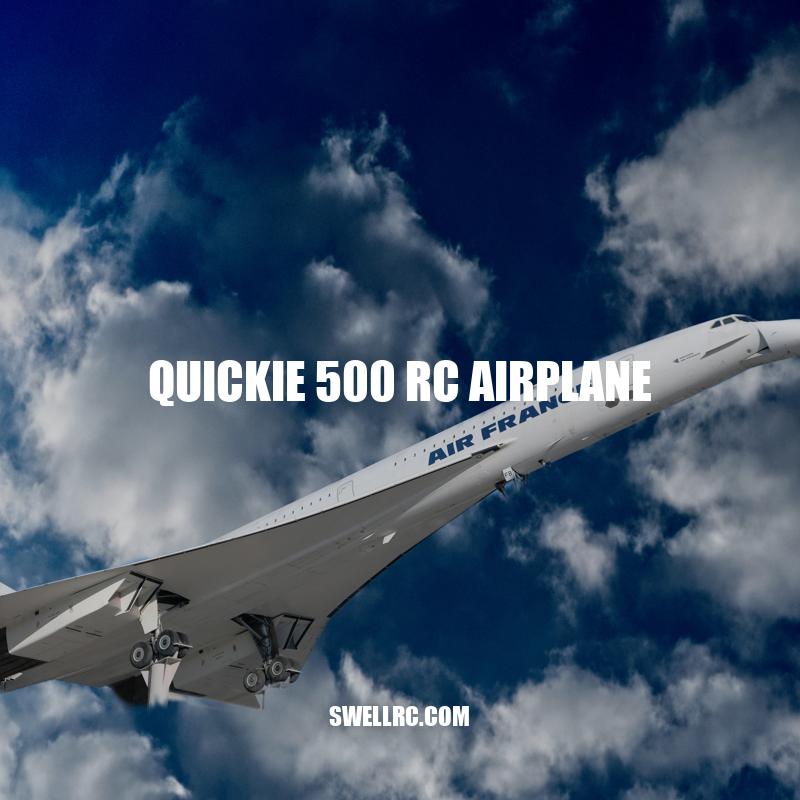Quickie 500 RC Airplane: High-Speed Flying Thrills and Essentials – A Guide
The Quickie 500 RC airplane is a popular model aircraft among hobbyists and RC enthusiasts alike. Known for its high speeds of up to 200 miles per hour, the Quickie 500 is a thrilling experience for anyone who loves to fly. The history of this popular RC plane dates back to the 1970s when Don Lowe, a well-known model airplane designer, first created the design. Over the years, the Quickie 500 has undergone various modifications to improve its aerodynamics and increase its speed, making it a formidable competitor in RC racing events. Building a Quickie 500 RC airplane can be a fun and rewarding experience, with pre-built kits or the chance to create a plane from scratch available. However, pilots must possess the skill and expertise required to fly this model plane successfully, especially given its high speeds and potential for crashes. Proper maintenance and repairs are also essential to keep the Quickie 500 RC airplane in top condition, ensuring that it remains a reliable and exciting model aircraft for years to come.
History of the Quickie 500
The Quickie 500 RC airplane has a rich history tracing back to the 1970s, with modifications having been made to its design to improve its speed and aerodynamics. Additional information regarding the history of the Quickie 500 includes:
- The original design was created by famed model airplane designer, Don Lowe.
- Don Lowe’s original design utilized cutting-edge technology that enabled the airplane to reach impressive speeds.
- Don Lowe’s Quickie 500 saw immediate popularity, with various modifications being made to enhance its aerodynamic capabilities and increase the speed capabilities of the airplane.
Today, the Quickie 500 RC airplane is a formidable competitor in RC racing events worldwide, its impressive speed and maneuverability making it a fan favorite. While the current model has seen some significant improvements compared to the original design, the core essence of the Quickie 500 remains the same, which is speed, agility and the ability to impress pilots and enthusiasts alike. For those interested in the Quickie 500 RC airplane, there are a variety of online resources to browse, including local hobby shops and major online marketplaces like Amazon and eBay, where users can find essential tools and purchase pre-built kits to streamline their building process.
What are some modifications made to improve the aerodynamics and speed of the Quickie 500 RC airplane?
The Quickie 500 RC airplane is an incredibly popular and thrilling experience for enthusiasts. It’s no surprise that many individuals look for modifications to help improve its aerodynamics and speed. Fortunately, there are a few modifications that can help pilots increase their experience.
One modification that pilots can make to improve the aerodynamics of their Quickie 500 is to add some winglets near the wingtips. These small vertical fins sit perpendicular to the wings and help reduce drag by countering the vortex generated by the wings’ tips. This reduces drag and increases speed.
Another modification that pilots can consider is changing the angle of attack of the wings. A lower angle of attack can reduce drag, making the airplane faster while a higher angle of attack provides more lift and increased stability. This modification is not for the faint of heart as it can have a significant impact on the aircraft’s handling.
Pilots can also look into adding a more powerful engine to increase the aircraft’s speed. However, it’s essential to note that this modification can cause the airplane to become unstable and, as such, should only be made by experienced pilots.
Finally, pilots can consider changing the shape of their aircraft, such as a more streamlined body or thinner wings. However, these modifications can be challenging to implement and may require expert knowledge to execute correctly.
In conclusion, there are many modifications that pilots can make to their Quickie 500 RC airplanes to improve their aerodynamics and speed. However, it’s crucial to consult an experienced individual before attempting any modifications and ensure that the aircraft’s performance and stability are not compromised.
Building the Quickie 500 RC Airplane
Building a Quickie 500 RC airplane can be a challenging but rewarding experience. Here are some tips and things to keep in mind when building your plane:
- Purchase a pre-built kit or gather the necessary materials to build your plane from scratch.
- Read and follow the instructions carefully to ensure that your plane is built to specification.
- Make sure you have all the necessary tools, including a hobby knife, glue, sandpaper, and a ruler.
- Pay close attention to the weight of your aircraft, as a heavy plane can negatively affect its overall performance.
When building your Quickie 500 RC airplane, it’s essential to have the right tools and materials. Here is a table of some essential materials you will need:
| Material | Purpose |
| Balsa wood sheets | Main structure of the airplane |
| Carbon fiber rods | Hold the wing and tail in place |
| Battery pack | Provides power to the motor |
| Control surfaces (rudders, ailerons, elevator) | Allows for control of the airplane |
With the right materials, a steady hand, and some patience, building your Quickie 500 RC airplane can be a rewarding and enjoyable experience.
What are some essential materials needed to build a Quickie 500 RC airplane?
To build a Quickie 500 RC airplane, there are several essential materials that you will need. The first and perhaps most important material is balsa wood, which is a lightweight wood that is perfect for constructing the frame and wings of your airplane. You will also need a selection of tools, including a hobby knife, sandpaper, and a ruler, to help you measure and cut the balsa wood to the correct shape and size.
In addition to balsa wood and tools, you will require a range of other materials to complete your Quickie 500 RC airplane. These include adhesives such as glue and epoxy, as well as wing covering material like heat-shrink plastic. You will also need a motor, propeller, speed controller, and servos to power and control your plane, along with a receiver and transmitter to communicate with it.
Lastly, it is essential to have a good set of instructions and plans to help you construct your Quickie 500 RC airplane correctly. This information will guide you in each step of the building process and ensure that your final plane is structurally sound and capable of flying safely.
Overall, building a Quickie 500 RC airplane can be an enjoyable and rewarding experience, but it is important to have the right materials and tools at hand to complete the project successfully.
Flying the Quickie 500 RC Airplane
Quickie 500 RC airplane is an exhilarating experience, but it’s important to keep safety in mind. Here are some tips to help you get started:
- Before you fly, always make sure that all components of your plane are in good working condition and that all batteries are charged.
- Check the weather conditions before flying, and avoid flying in high winds or thunderstorms.
- Choose a safe flying location, preferably an open field with no people or obstacles.
- Practice your takeoff and landing techniques before trying any fancy maneuvers.
- Understand your plane’s capabilities and limitations, and fly within those parameters.
If you’re new to flying RC airplanes or want to improve your skills, there are many resources available online. Websites like RCGroups.com and FliteTest.com offer forums and tutorials for beginners and advanced pilots alike. Additionally, there are simulator programs available that allow you to practice flying without the risk of crashing your actual plane. Some popular simulators include:
| Simulator | Price | Features |
| RealFlight | $99.99 | Over 140 aircraft, multiplayer mode, virtual reality compatibility |
| Phoenix RC | $119.99 | Simulates real-world physics, customizable physics settings |
| AeroSim RC | $49.99 | Realistic flight dynamics, beginner and advanced modes |
By utilizing these resources and practicing safe flying techniques, you can fully enjoy the excitement and adventure of flying your Quickie 500 RC airplane.
What are some popular simulator programs for practicing flying RC airplanes?
If you’re getting into the world of flying remote control (RC) airplanes, it’s important to gain practice before taking your aircraft to the skies. Luckily, there are several popular simulator programs that can help you refine your flying skills.
One of the top simulator programs on the market and frequently recommended by RC enthusiasts is RealFlight. This simulator offers a vast range of features, including over 140 aircraft models, photorealistic scenery, and the ability to fly in various weather conditions. Plus, RealFlight offers multiplayer options, allowing you to connect with other pilots and share in the experience.
Another favorite for many in the RC community is Phoenix R/C Pro Simulator. This program provides realistic physics and control, making it feel like you’re actually flying the plane. Additionally, Phoenix R/C Pro Simulator includes a wide range of aircraft models, locations, and weather conditions to ensure you’re ready for any scenario.
Finally, there’s the popular AeroSIM RC simulator. Similar to the others, it offers a multitude of aircraft options and flying conditions. One unique aspect of AeroSIM RC simulator is its ability to simulate different types of RC planes, from helicopters to gliders, and even drones.
No matter which simulator program you choose, practicing your flying with these programs will significantly increase your skills as an RC pilot. So take advantage of these resources and take to the virtual skies!
Proper maintenance and repairs are essential to keep your Quickie 500 RC airplane in top condition. Here are some tips for maintaining your plane:
- Regularly inspect your plane for damage and signs of wear and tear. Look for cracks, dents, loose screws, and other issues.
- Clean your plane after each use to prevent buildup of dirt and debris.
- Store your plane in a dry, cool place to prevent warping and other damage.
- Replace any damaged parts as soon as possible to avoid further damage or accidents.
In addition to regular maintenance, it’s also important to have the necessary tools and replacement parts on hand in case you need to make repairs. Some essential tools for maintaining your Quickie 500 RC airplane include:
- Screwdrivers and pliers for tightening screws and other connections
- A heat gun or hair dryer for shrinking heat shrink tubing
- Battery charger and spare batteries
- Adhesive tape for temporary fixes
- Replacement parts such as propellers, landing gear, and control surfaces
Finding replacement parts for your Quickie 500 RC airplane is relatively easy, as many online hobby shops carry a wide variety of parts and accessories. Some popular websites for purchasing RC airplane parts include HorizonHobby.com, HobbyKing.com, and TowerHobbies.com. These websites offer a wide variety of parts and accessories for RC airplanes, including the Quickie 500.
By following these maintenance and repair tips and having the necessary tools and replacement parts on hand, you can ensure that your Quickie 500 RC airplane stays in top condition and continues to provide you with hours of high-speed, thrilling flights.
What are some popular websites for purchasing RC airplane parts for the Quickie 500?
If you’re looking for RC airplane parts for your Quickie 500, there are several popular websites that offer a wide selection. One of the most well-known sites is Horizon Hobby, which offers an extensive range of parts and accessories for all types of RC airplanes.
Another popular website for purchasing RC airplane parts is Tower Hobbies, which offers a broad range of components for hobbyists of all levels. From propellers and engines to batteries and servos, Tower Hobbies has everything you need to keep your Quickie 500 flying high.
RC Planet is another great website to check out for Quickie 500 parts, with a vast selection of components from leading brands like APC, Dubro, and Hitec. Not to mention, their prices are very competitive.
Lastly, Heads Up RC is an excellent option for those looking for affordable and high-quality RC airplane parts. Their website offers a comprehensive selection of components that will fit your Quickie 500 at a reasonable price.
Regardless of which website you choose, make sure to check out their shipping policies and customer reviews to ensure a smooth shopping experience. Happy flying!
Conclusion
In conclusion, the Quickie 500 RC airplane is a high-speed model aircraft that is popular among hobbyists and enthusiasts. With its long history, easy-to-build kits, and high-performance capabilities, this plane is a great option for anyone looking for a thrilling and exciting flying experience.
Whether you’re a seasoned RC pilot or just starting out, the Quickie 500 is a great plane to add to your collection. With its impressive speed and maneuverability, you’re sure to have plenty of fun flying this plane. And by following the maintenance and repair tips outlined in this article, you can ensure that your Quickie 500 stays in top condition and continues to provide you with hours of entertainment.
So what are you waiting for? Order your Quickie 500 RC airplane kit today and take to the skies! With its sleek design, powerful engine, and easy-to-build kit, you’ll be hitting speeds of up to 200 miles per hour in no time.



